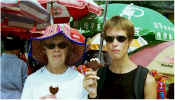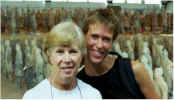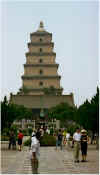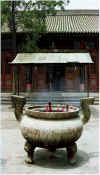Where China Began
Friday 9 July 1999 Ė Saturday 10 July
1999
 We flew to Xian from Beijing,
leaving on the earliest flight we could in order to get there with time to spare
in the day to wander round and see the sights. As it transpired, we did almost nothing the first day but on
the next morning, together with a car and driver, started out on a sightseeing
tour that covered nearly every monument and monastery there was to see.
We flew to Xian from Beijing,
leaving on the earliest flight we could in order to get there with time to spare
in the day to wander round and see the sights. As it transpired, we did almost nothing the first day but on
the next morning, together with a car and driver, started out on a sightseeing
tour that covered nearly every monument and monastery there was to see.
Xian is famous for its
terracotta army: an archeological find on a monumental scale. It is literally an earthen army, comprised of over 8,000
life-sized terracotta figures with individual features apparently modeled on
real people. They were unearthed by local residents attempting to dig a well in
1974. The army was made to order
for Chinaís first emperor, Qin Shihuangdi, to guard his tomb. So far so
good, as archaeologists are so busy assembling the warriors that the emperor's
tomb has yet to be excavated. To date only 2,000 of the soldiers have been
unearthed, and many more discoveries are expected to be found.
Chinaís first emperor, Qin Shihuangdi, to guard his tomb. So far so
good, as archaeologists are so busy assembling the warriors that the emperor's
tomb has yet to be excavated. To date only 2,000 of the soldiers have been
unearthed, and many more discoveries are expected to be found.
 The
main exhibit is housed within a huge hangar and covers a total area of 12,600
square metres (lots of square feet).
The
area is patrolled by police in order to prevent people from taking photographs,
thereby ensuring you will have no choice but to buy one of the many 10-postcard
packs on sale outside. It is a
spectacular sight (the soldiers, not the postcards) although excavations are
notoriously slow and will continue for many, many years to come, so what we saw
was probably only a very small percentage of what actually lies below ground.
The
main exhibit is housed within a huge hangar and covers a total area of 12,600
square metres (lots of square feet).
The
area is patrolled by police in order to prevent people from taking photographs,
thereby ensuring you will have no choice but to buy one of the many 10-postcard
packs on sale outside. It is a
spectacular sight (the soldiers, not the postcards) although excavations are
notoriously slow and will continue for many, many years to come, so what we saw
was probably only a very small percentage of what actually lies below ground.
From there, we headed back
towards the centre of town via the Huanqing Hot Springs.  Neither Eric nor Pippaís mum were particularly inspired by
this one, but Pippa was adamant for reasons that remain a mystery. It was
sadly not as scenic as it had presumably been during the Tang Dynasty and we
didnít stay long enough to take a dip.
Neither Eric nor Pippaís mum were particularly inspired by
this one, but Pippa was adamant for reasons that remain a mystery. It was
sadly not as scenic as it had presumably been during the Tang Dynasty and we
didnít stay long enough to take a dip.
 Among
the other landmarks we covered that day was the Banpo Museum, the remains of a
Late Stone Age Village. It is
remarkably well preserved and has an impressive collection of implements and
utensils on display. We
then visited a Taoist
Temple (the Temple of the Eight Immortals) on the outskirts of town, followed by
the Big Goose Pagoda, one of Xianís most distinctive landmarks.
It is a five story tower, built of brick and boasting an
inexplicable name. Our last stop of the day was the Shaanxi History Museum, a
world-class display of Chinese applied arts through the ages (Shang bronzes,
Ming porcelain, that sort of thing).
Among
the other landmarks we covered that day was the Banpo Museum, the remains of a
Late Stone Age Village. It is
remarkably well preserved and has an impressive collection of implements and
utensils on display. We
then visited a Taoist
Temple (the Temple of the Eight Immortals) on the outskirts of town, followed by
the Big Goose Pagoda, one of Xianís most distinctive landmarks.
It is a five story tower, built of brick and boasting an
inexplicable name. Our last stop of the day was the Shaanxi History Museum, a
world-class display of Chinese applied arts through the ages (Shang bronzes,
Ming porcelain, that sort of thing).
That evening, exhausted and
hungry, we were served up the worst meal we had suffered during our entire
trip and sought refuge in a pizza and beer while watching Xianís only all-female band, the Red Hot Chilies.
